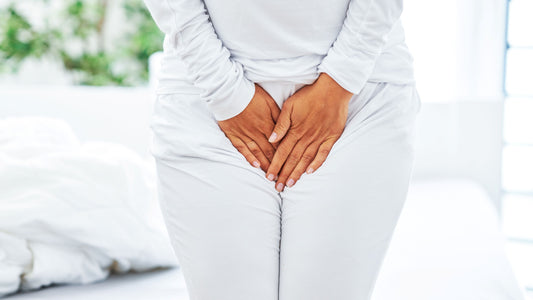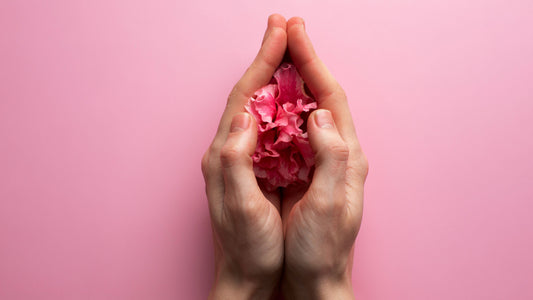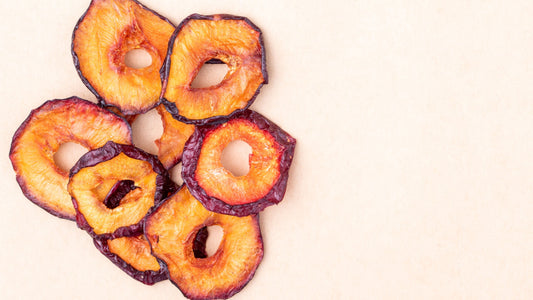Menopause brings many changes to your body — and vaginal wellness is one of the least talked about. We don’t feel entirely comfortable talking about the way toilet paper feels like it’s tearing your labia or sex feels like two pieces of sandpaper rubbing together.
But if this is your experience, take heart. Vaginal atrophy during menopause is extremely common, and while it affects your comfort. Your relationship. And your overall quality of life…you don’t have to put up with it.
Allow me to help you navigate this all-too-common struggle with confidence and clarity.
In this article, you will learn:
What causes vaginal atrophy and dryness during menopause
The best options for relieving discomfort
Daily vaginal care habits to support long-term vaginal wellness
Let’s start by understanding what vaginal wellness really means in the context of menopause.


Vaginal wellness refers to the overall health, comfort, and functionality of the vaginal and vulvar area — including moisture levels, tissue strength, pH balance, and microbial health. During the reproductive years, estrogen helps maintain all of these things. But as estrogen declines in menopause, the vaginal environment begins to shift. Often dramatically.
These hormonal changes can lead to thinner vaginal tissues, reduced elasticity, and decreased natural lubrication. This is why so many women experience issues like discomfort, irritation, more frequent yeast infections and UTIs, and pain during intercourse.
A key aspect of vaginal wellness during menopause is understanding that these symptoms aren’t isolated. They’re part of a larger condition known officially as vaginal atrophy, which is actually a part of the broader condition known as genitourinary syndrome of menopause, or GSM.
Vaginal care at this stage becomes less about occasional hygiene and more about daily support. It’s about listening to your body, learning what’s normal and what’s not, and adjusting your routine to reflect the new needs of your vaginal and vulvar tissues.
Maintaining vaginal wellness in menopause means prioritizing your self-care, addressing discomfort early, and breaking the stigma around talking about vaginal health.
The Link Between Vaginal Dryness And Overall Vaginal Wellness
Vaginal dryness and menopause seem to go hand in hand. In fact, vaginal dryness is often the first and most noticeable symptom of declining vaginal wellness during perimenopause and menopause. As estrogen levels fall, the vaginal lining produces less natural lubrication, leading to a feeling of tightness, friction, itchiness, or even rawness — especially during intimacy or exercise.
This dryness isn’t just physically uncomfortable; it can have a ripple effect on your confidence, relationships, and overall well-being. Many women avoid sex altogether out of fear of pain, while others begin to feel disconnected from their bodies (and their partners).
And while we often get the message during menopause that all of our discomfort or pain is “normal,” you don’t want to ignore vaginal dryness.
Ignoring dryness can lead to further complications, such as small tears in the tissue or an increased risk of infections. That’s why it’s important to integrate dryness care into your daily vaginal care routine — whether that’s with gentle moisturizers, lubricants, or lifestyle adjustments.
By treating vaginal dryness early and consistently, you’re not just soothing discomfort — you’re investing in long-term vaginal wellness.
Vaginal Wellness Solutions
Soothing discomfort from vaginal atrophy and vaginal dryness isn’t a one-size-fits-all situation. The right approach depends on you.
For many women, non-hormonal lubricants and vaginal moisturizers are the first line of defense.
- Lubricants are used during intercourse to reduce friction.
- Moisturizers help revitalize vaginal tissue when used regularly, improving comfort even outside of intimacy.
- My patented Julva® cream is formulated to support comfort and self-care during menopause. It contains DHEA and other skin-nourishing ingredients. Check out the thousands of raving reviews for Julva® here.
If dryness or atrophy is truly plaguing you with discomfort, your doctor might recommend localized hormone therapy.
- Vaginal estrogen (cream, ring, or tablet) delivers estrogen directly to the affected tissue.
- DHEA (dehydroepiandrosterone) is another hormone option inserted vaginally to support elasticity and moisture.
Unlike systemic hormone therapy, these localized treatments have minimal absorption and fewer risks for most women.
Don’t forget, your diet matters, too. Eating a healthy range of vegetables and healthy fats could help pretty much everything during menopause.
And, regular pelvic floor exercises or physical therapy can improve circulation and muscle tone in the pelvic region — which could in turn help with discomfort.
Most importantly, don’t suffer in silence. Talk to your healthcare provider openly about your symptoms and what treatments align with your values and goals. Do not be embarrassed to bring this up with your doctor.
Daily Vaginal Care Habits For Long-Term Vaginal Wellness
Maintaining vaginal wellness through menopause and beyond isn’t just about treating symptoms when they appear — it’s about creating a daily care routine that supports long-term comfort and health.


Overwashing or using harsh soaps can disrupt the vagina’s natural pH and microbiome.
Use warm water and mild, unscented cleansers on the outer vulva only. Your vagina is “self-cleaning” and you should never need to put soap inside.
Avoid douches, vaginal wipes, or heavily fragranced products marketed for "freshness."
Less is often more when it comes to vaginal care.


Tight underwear and synthetic fabrics can trap moisture and create irritation.
Opt for breathable cotton panties and experiment with not wearing underwear overnight if possible.
Change out of damp workout clothes or swimsuits promptly.


When it comes to your vaginal tissues in menopause, we often say “If you don’t use it, you lose it.” This means you want to encourage any activity that gives the area some attention (blood flow).
Regular sexual activity or vaginal stimulation could increase blood flow and help maintain vaginal tissue health. If sex is uncomfortable, use lubricants or talk to your partner about alternatives that feel good for you.


Annual pelvic exams remain important during and after menopause. Don’t wait for extreme discomfort to bring up issues. Be your own advocate.
These small habits, practiced consistently, create the foundation for lifelong vaginal wellness.
Vaginal Wellness In Menopause
Girlfriend, now is the time to focus on you and your self-care.
Your vaginal wellness compounds over time, so getting into good daily habits now can mean a smoother menopausal transition later, and that’s definitely an investment worth making.
My daily non-negotiable habit is Julva, my patented vaginal and vulvar revitalizer. It’s packed with good-for-your-v ingredients and many women report feeling more confident and connected with consistent use of Julva as part of their self-care routine.
Be sure to check out the thousands of raving reviews for Julva® here.
Julva® is not intended to diagnose, treat, cure, or prevent any disease. Results may vary. Talk to your doctor before using any product containing hormones.





